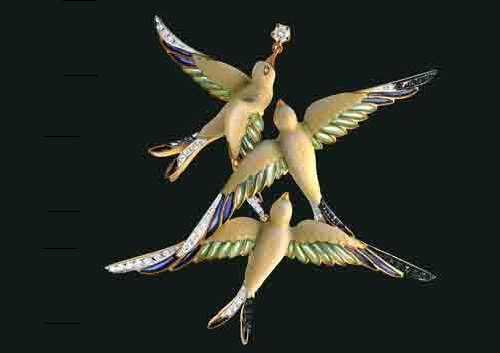Catalan jeweler Lluis Masriera

Brooch Pendant with nymph, made in the workshop of Catalan jeweler Lluis Masriera. (Courtesy Balcli’s)
Catalan jeweler Lluis Masriera (17 January 1872 – 21 October 1958)
Born in Barcelona, Lluis Masriera i Roses was a famous goldsmith, painter, set designer, playwright and theater director. He was the most important member of the Masriera family because he continued the family tradition. Third generation painter and goldsmith, he gave an international fame to his family. The creator of Barcelona enamel of extreme fragility and beauty, he made his contribution as enameller in the technique of plique-A- jour.
His personal style was based on Art Nouveau influences of Rene Lalique. He made exhibitions in Barcelona, Zaragoza, Madrid, Paris, Buenos Aires and San Francisco, both as a goldsmith and artist.
Lluis Masriera became a benchmark figure in the cultural world of Barcelona in the first half of the twentieth century. In addition, he became internationally recognized as one of the most prominent Art Noveau artists jewelers. Today his jewels are highly appreciated, valued and internationally known. An example of this was the auction featuring works by Masriera organized by Christie’s in Geneva in 1970.
Lluis Masriera was the son of Joseph and Clotilde Manovens Masrieras; and nephew of Francis and Masrieras Manovens. He had three brothers, Joseph, William and Richard, and a sister Elizabeth, who died very young. He married on 23 October 1897 and had 6 children.
Catalan jeweler Lluis Masriera
The unique and exceptional talent of Masriera was based on a strong tradition and a good knowledge of the trade. He started working in the family workshop at the age of 15. He attended classes at the School of Fine Arts with his brother Joseph. His brother Joseph was shortly involved in jewelry design, working in the family business at the Paris Universal Exhibition of 1889; then moved to Geneva in 1901 to focus on drawing and artistic industries. William devoted himself to drawing and sculpture; but Louis stood above all and became the leading figure of the Spanish and Catalan Modernist Jewelry moment.
On 31 January 1912 his father died and Lluís Masriera was forced to take the family business together with his brother Richard.
From 1900 there was a big change in his work as a result of direct contact with the creations of Rene Lalique in Paris. The new collection was exhibited in the shop window of the Ferran street 21 December 1901 and had a great success…. Birds are the main protagonists of the jewels of Masriera from 1901, the cranes, the herons, roosters and peacocks, one of the most characteristic birds of Symbolism and Art Nouveau. The artist played with the colors of translucent enamel to give the symbolism of the transformation of nature. His work has many parallels with the pre-Raphaelite iconography – flower-girls, night birds and butterflies.
Catalan jeweler Lluis Masriera
The jewels of Masriera have a well-defined personality. In 1906 he was commissioned to design the diadem on the promise of marriage of Victoria Eugenie of Battenberg with King Alfonso XIII, a rich treasure of gold, silver, carved wood, ivory and enamel plique-A- jour and the bouquet holder.
As for the liturgical pieces of jewelry designed by Masriera workshops they didn’t preserve due to the vicissitudes of the war period that affected the heritage of the church. Among the lost treasures of Masriera – golden crosier designed for the Bishop of Girona in 1905, made in gold and silver gilt enamel plique-à-jour, with precious stones. However, the crozier of the Bishop of Tui of 1907, has survived, made in gold and silver, embossed and engraved with diamonds, sapphires, amethysts and painted enamel plique-à-jour, on which worked three Masriera brothers. The liturgical silverware, applying enamel plique-à-jour, reached the highest artistic quality of Modernism in 1913 – 1924.
Under the influence of Russian ballets, new archaeological discoveries and the resurgence of interest in places like the Middle East and India emerged a new style “Eastern” which influenced fashion and jewelry from the first quarter of the century XX.
Works by Catalan jeweler Lluis Masriera

Fairy pendant necklac. Gold and silver, enamel ‘plique-à-jour’ and ‘basse taille’ cut diamonds, 0.85 carats; sapphires and brilliant cut, 0.95 carats. Signed ‘Masriera and Carreras’






















